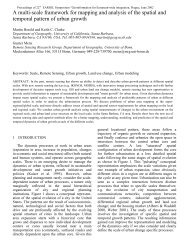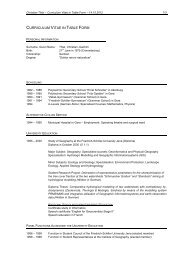Using Geomatica Software - Fernerkundung Jena - Friedrich ...
Using Geomatica Software - Fernerkundung Jena - Friedrich ...
Using Geomatica Software - Fernerkundung Jena - Friedrich ...
Create successful ePaper yourself
Turn your PDF publications into a flip-book with our unique Google optimized e-Paper software.
ARE<br />
REC<br />
Elevation Data Area under Bitmap. Calculates the true and<br />
projected areas, under a user-selected bitmap, from an elevation<br />
image.<br />
Creates or overwrites a 256-value database lookup table segment<br />
which can be used to transform or recode 8-bit image data stored<br />
on database image channels. Unspecified lookup table values can be<br />
defaulted to either zero or identity. No image data is changed.<br />
Vector Utilities:<br />
Raster vectorisation process flow: RTV -> VECMERGE -> VECCLEAN<br />
Raster statistics under buffered vector polygons, process flow: GRDPOL -> SCALE -><br />
SHRINK -> THR -> MODEL -> RTV -> VIMAGE -> VECREP<br />
CONTOUR<br />
GRD<br />
GRDINT<br />
GRDPIN<br />
GRDPNT<br />
GRDPOL<br />
GRDVEC<br />
IDINT<br />
KRIGING<br />
RBFINT<br />
RTV<br />
Contour Generation from Raster Image. Creates a vector segment<br />
containing contour lines from a raster image, such as an elevation<br />
(DEM) image, given a specified contour interval. The contour value<br />
for each line is saved in either the Z-coordinate of all vertices or in a<br />
separate attribute field.<br />
Vector Grid Interpolation, Grids (fills in) the raster image channel,by<br />
interpolating image data between encoded vector data (normally<br />
created by the GRDVEC program). GRDVEC and GRDINT can be<br />
used to create digital elevation models (DEM).<br />
Point Grid Interpolation Generates a raster image by interpolating<br />
image values between specified pixel locations. Optionally<br />
associated with each input pixel grey level is a user-specified<br />
confidence level.<br />
Point Coverage Gridding Given a set of points stored in a vector<br />
segment, a raster image is generated where each grey level<br />
corresponds to the attribute value of the closest point.<br />
Polygon Coverage Gridding Convert polygons or arcs in vector<br />
segments to raster image or bitmap.<br />
Vector Encoding Encodes (burns in) vector data into existing raster<br />
image channel. The attribute value associated with each line and<br />
point in the vector segment is encoded into the image channel. The<br />
GRDINT program is used to grid (fill in) raster values between<br />
encoded vectors in the image channel. GRDVEC and GRDINT can<br />
be used to create a digital elevation mode (DEM) from contours.<br />
Inverse Distance Interpolation Generates a raster image by<br />
interpolating image values between specified pixel locations using<br />
the Simple Inverse Distance or Weighted Inverse Distance<br />
algorithm.<br />
Point Interpolation with Kriging Generates a raster image by<br />
interpolating points specified in vector segments, using the kriging<br />
method.<br />
Radial Basis Function Interpolation Generates a raster image by<br />
interpolating image values between specified pixel locations using a<br />
Radial Basis Interpolation Algorithm. This program implements the<br />
Multi-Quadric and the Thin Plate Spline schemes.<br />
Raster to Vector Conversion Takes as its input a raster image held<br />
in a channel on a PCIDSK file (preferably one which has been<br />
classified and/or well filtered). RTV then outputs vector data<br />
describing the boundaries and/or interior points of the areas<br />
(polygons) in the image. The generated vector data is stored in a<br />
created vector segment in the file.






